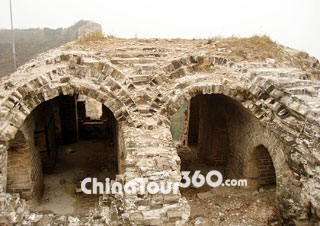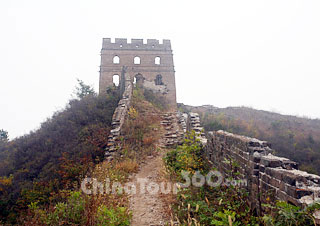Admission Fee: CNY25
Opening Hours: All Day
Best Visiting Time: Autumn (September to October)
Location: Located in Miyun County, Gubeikou Great Wall is just about 120 km (74.6 miles) from downtown Beijing.
![]() Introduction: With complete great wall system, Gubeikou is made up of Wohu and Panlong mountains, Jinshanling and Simatai. It is regarded as the only well-preserved wall from the original Ming Dynasty (1368 - 1644) wall. The present wall spreads around 40 km (24.8 miles), consisting of 143 watch towers, 14 beacon towers, 16 strategic passes, three water passes and many other military constructions. The outside appearance of the towers is similar, but their inside design varies greatly, especially the ceilings which can be flat, arched or domed.
Introduction: With complete great wall system, Gubeikou is made up of Wohu and Panlong mountains, Jinshanling and Simatai. It is regarded as the only well-preserved wall from the original Ming Dynasty (1368 - 1644) wall. The present wall spreads around 40 km (24.8 miles), consisting of 143 watch towers, 14 beacon towers, 16 strategic passes, three water passes and many other military constructions. The outside appearance of the towers is similar, but their inside design varies greatly, especially the ceilings which can be flat, arched or domed.
Gubeikou Pass, flanked by the high Panlong and Wohu mountains in the east and west and with the Chaohe River flowing through, is a strategic gorge which has linked the southern and northern areas of the Yanshan Range since the ancient times. The most representative architecture feature in the pass is the water gate on the Chaohe River which is so narrow that it only allows the passage of one rider at a time. From outside the gate, a 750-meter-long (820.2 yards) cavity wall spreads towards the northeast and the northwest, shaped like a dragon's beard. Three towers were built on each wall section.
![]() History: The earliest part of the wall was built by the Northern Qi Dynasty (550 - 577) to protect the country aganist attacks from Turk, Xi and Khitan nomadic tribes. However, since walls were mostly built with mud and stone, and were low and small, only a few sites have been preserved. Thereafter, the Sui (581 - 618) and Tang (618 - 907) dynasties constantly renovated and used the walls, and during the Jin Dynasty (1115 - 1234), an iron gate was built to guard the pass. That's why the Pass is also named 'Iron Gate Pass'. It became impregnable during the Ming Dynasty. After overthrowing the Tartar tribes, Emperor Zhu Yuanzhang, founder of the Ming Dynasty, sent Xu Da to built Juyongguan, Gubeikou, Xifengkou passes, beacon towers and other supporting facilities. At the same time, the walls' height was raised by the addition of another layer of stones, and another two gates were added at the pass to strengthen its defenses. Then another 100 years later, Qi Jiguang, a military general and national hero of the Ming Dynasty, was sent to rebuild the wall. During the renovations, he kept the earliest Northern Qi walls, and built another layer of bricks on the outside. Through his hard work, a firm defensive line made up of high walls, beacon tower, watch towers and other military constructions was erected.
History: The earliest part of the wall was built by the Northern Qi Dynasty (550 - 577) to protect the country aganist attacks from Turk, Xi and Khitan nomadic tribes. However, since walls were mostly built with mud and stone, and were low and small, only a few sites have been preserved. Thereafter, the Sui (581 - 618) and Tang (618 - 907) dynasties constantly renovated and used the walls, and during the Jin Dynasty (1115 - 1234), an iron gate was built to guard the pass. That's why the Pass is also named 'Iron Gate Pass'. It became impregnable during the Ming Dynasty. After overthrowing the Tartar tribes, Emperor Zhu Yuanzhang, founder of the Ming Dynasty, sent Xu Da to built Juyongguan, Gubeikou, Xifengkou passes, beacon towers and other supporting facilities. At the same time, the walls' height was raised by the addition of another layer of stones, and another two gates were added at the pass to strengthen its defenses. Then another 100 years later, Qi Jiguang, a military general and national hero of the Ming Dynasty, was sent to rebuild the wall. During the renovations, he kept the earliest Northern Qi walls, and built another layer of bricks on the outside. Through his hard work, a firm defensive line made up of high walls, beacon tower, watch towers and other military constructions was erected.
![]() Scenic Spots: There are many historical features from west to east, Bada Louzi, Huangyugou, Wohu Mountain, Wanshou Mountain, Panlong Mountain, Wulituo, Jinshanling and Simatai great walls. The well-known Big Flower Beacon Tower of the Northern Qi Dynasty, Twin Towers, Fairy Tower, General Tower, 24-Eye Tower and the commanding Wangjing Tower are erected on these walls. In their vicinity are some ancient temporary imperial palaces, Yanglinggong Temple and the Temple of the King of Medicine where a big fair is held on September 14 of the lunar calendar every year.
Scenic Spots: There are many historical features from west to east, Bada Louzi, Huangyugou, Wohu Mountain, Wanshou Mountain, Panlong Mountain, Wulituo, Jinshanling and Simatai great walls. The well-known Big Flower Beacon Tower of the Northern Qi Dynasty, Twin Towers, Fairy Tower, General Tower, 24-Eye Tower and the commanding Wangjing Tower are erected on these walls. In their vicinity are some ancient temporary imperial palaces, Yanglinggong Temple and the Temple of the King of Medicine where a big fair is held on September 14 of the lunar calendar every year.
![]() Transportation:
Transportation:
A. Take bus No. 980 from Dongzhimen to Miyun Bus Station, transfer to a mini-bus to the scenic area.
B. Take a bus towards Chengde, Luanping, Weichang or Fengning from Xizhimen or Dongzhimen to the toll station at Gubeikou, from where you will see the wall.
![]() Dining and Accommodation: Almost all of the farmhouses near the scenic spot receive tourists, providing both home-style food and lodging. The most popular local specialties are Manchu-style snacks of more than 30 varieties. More restaurants, hotels, hostels and guesthouses can be found in Miyun County, which is one hour's drive from the town.
Dining and Accommodation: Almost all of the farmhouses near the scenic spot receive tourists, providing both home-style food and lodging. The most popular local specialties are Manchu-style snacks of more than 30 varieties. More restaurants, hotels, hostels and guesthouses can be found in Miyun County, which is one hour's drive from the town.
![]() Popular Tour Routes:
Popular Tour Routes:
A. Panlong Mountain Scenic Area: Gubeikou Town City Wall Site → Big Flower Beacon Tower → Ancient Brick Kiln Site → Paodonggou Pass → General Tower → 24-eye tower
B. Wohu Mountain Scenic Area: City Wall Site → Qilang Tomb → Wanshou Temple → Jianmian Stone → Duantou Platform → Jiulian Zhaoyang Pagoda → Shensong Tower → Cloud Stair → Tiger Tower
C. Memorial Hall → Big Flower Beacon Tower → Gubeikou Ancient Pass City → Ancient King's Road → Temple of the King of Medicine → God of Wealth Temple → Yanglinggong Temple → Three-eye Well → Palace Lights in King's Road → Cultural Courtyard → Folk-custom Exhibition Hall → Erlang Temple → Seven Soldiers' Monument, Watching Films or Zigzagging Yellow River Lantern Formation, and climbing Panlong Mountain or Wohu Mountain Great Wall
D. Gubeikou Pass → Panlong Mountain → Jinshanling
![]() Recommended China Great Wall Tours:
Recommended China Great Wall Tours:
4-Day Beijing Travel: to the most popular attractions in the city
Essence of Beijing Tour: 5-Day to visit Badaling Great Wall and more highlight attractions
Essence of China Tour: 8-Day of China Small Group Tour of Beijing - Xian - Shanghai
Best China Resorts: 10-Day of Beijing - Xian - Guilin - Yangshuo - Guilin - Shanghai
More China Great Wall Tours










